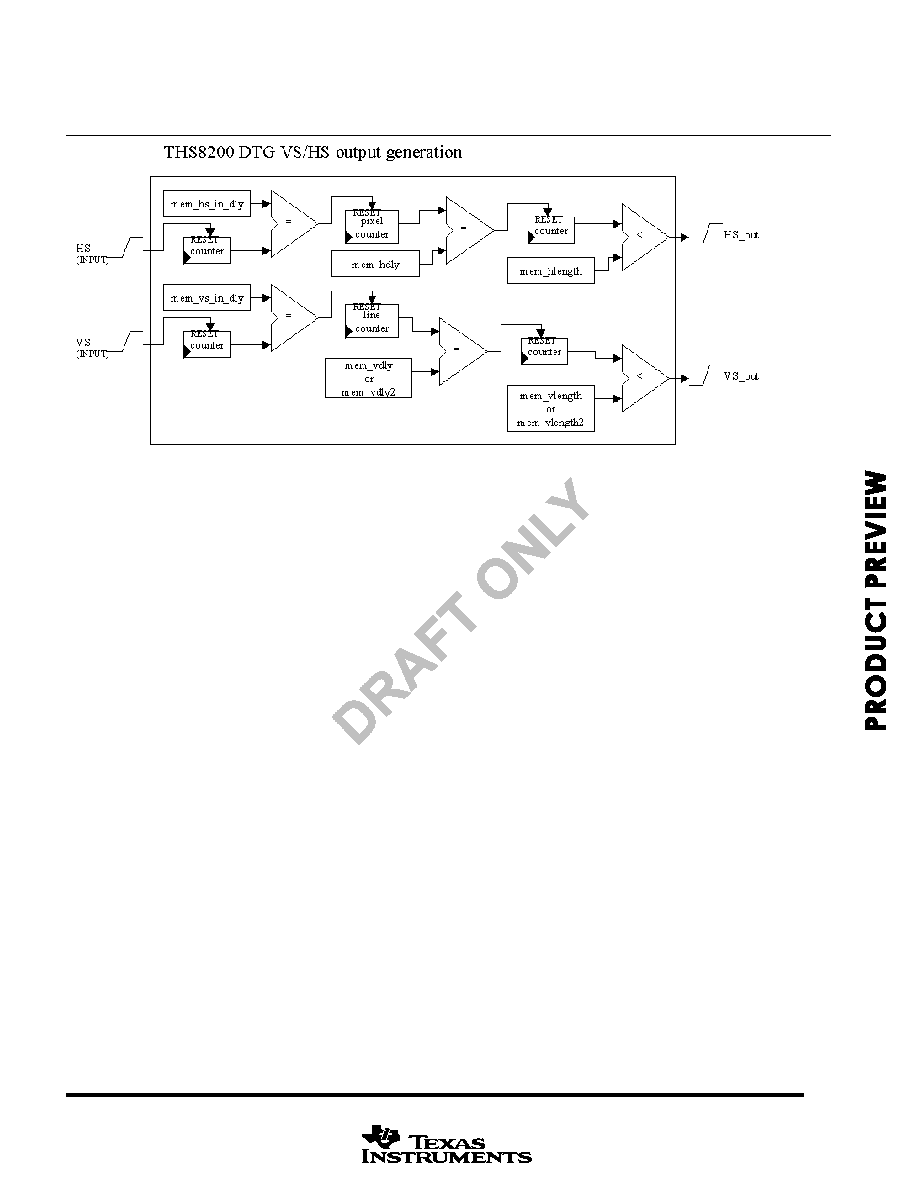- 您現(xiàn)在的位置:買賣IC網(wǎng) > PDF目錄98229 > THS8210PFP (TEXAS INSTRUMENTS INC) SPECIALTY CONSUMER CIRCUIT, PQFP80 PDF資料下載
參數(shù)資料
| 型號(hào): | THS8210PFP |
| 廠商: | TEXAS INSTRUMENTS INC |
| 元件分類: | 消費(fèi)家電 |
| 英文描述: | SPECIALTY CONSUMER CIRCUIT, PQFP80 |
| 封裝: | POWER, PLASTIC, TQFP-80 |
| 文件頁(yè)數(shù): | 26/73頁(yè) |
| 文件大?。?/td> | 2053K |
| 代理商: | THS8210PFP |
第1頁(yè)第2頁(yè)第3頁(yè)第4頁(yè)第5頁(yè)第6頁(yè)第7頁(yè)第8頁(yè)第9頁(yè)第10頁(yè)第11頁(yè)第12頁(yè)第13頁(yè)第14頁(yè)第15頁(yè)第16頁(yè)第17頁(yè)第18頁(yè)第19頁(yè)第20頁(yè)第21頁(yè)第22頁(yè)第23頁(yè)第24頁(yè)第25頁(yè)當(dāng)前第26頁(yè)第27頁(yè)第28頁(yè)第29頁(yè)第30頁(yè)第31頁(yè)第32頁(yè)第33頁(yè)第34頁(yè)第35頁(yè)第36頁(yè)第37頁(yè)第38頁(yè)第39頁(yè)第40頁(yè)第41頁(yè)第42頁(yè)第43頁(yè)第44頁(yè)第45頁(yè)第46頁(yè)第47頁(yè)第48頁(yè)第49頁(yè)第50頁(yè)第51頁(yè)第52頁(yè)第53頁(yè)第54頁(yè)第55頁(yè)第56頁(yè)第57頁(yè)第58頁(yè)第59頁(yè)第60頁(yè)第61頁(yè)第62頁(yè)第63頁(yè)第64頁(yè)第65頁(yè)第66頁(yè)第67頁(yè)第68頁(yè)第69頁(yè)第70頁(yè)第71頁(yè)第72頁(yè)第73頁(yè)

THS8200/8210
‘ALL-FORMAT’ OVERSAMPLED COMPONENT VIDEO/PC GRAPHICS D/A SYSTEM WITH
THREE 11 BIT DAC’S, CGMS DATA INSERTION AND 525P MACROVISION
TM COPY
PROTECTION
SLES032—6/18/02 3:33 PM
POST OFFICE BOX 655303 DALLAS TEXAS 77265
32
Copyright 2001 Texas Instruments Incorporated
PRODUCT PREVIEW information concerns products in the
formative or design phase of development. Characteristic data
and other specifications are design goals. Texas Instruments
reserves the right to change or discontinue these products
without notice.
Note that both independent sets of delay registers allow to accommodate different input timing references in slave
mode. When the device is configured in master mode, the delay registers can compensate for different external
(frame memory) synchronization requirements.
Output synchronization: composite sync
The composite sync is generated from a programmed sequence of (linetype, line_breakpoint) combinations, either
user-programmed (in generic mode) or pre-set (in preset mode). The linetype determines the waveform shape at
the output of the DAC(s) with programmable amplitudes and timings.
On each line, at the horizontal reference point of the DTG (see later on how this position is determined), the DTG
decides where to start/stop the DTG generated data and where to pass input video data (e.g. during an active
video line, ancillary data may be embedded in the digital stream outside the active video portion of the line, that we
might want to convert to analog OR during a non-active video line, where normally the predefined linetype would be
inserted, ancillary data might need to be passed during the ‘a(chǎn)ctive’ video portion of the line).
The amplitudes of positive, negative sync excursions and of the negative serration, pre- & post-equalization and
‘broad’ pulses are programmable, independently between G/Y and BPb,RPr channels. Therefore sync insertion
can be programmed on only G/Y output or all DAC outputs.
In order to limit the number of selection bits to select the linetype, and because of the fact that we can define a set
of linetypes that is mutually exclusive for SDTV and HDTV video modes, there are two DTG_video_formats: SDTV
& HDTV. There is a third DTG mode (VESA) which does not use the linetype/breakpoint state machine and only
generates Hsync/Vsync outputs.
Output synchronization: Hsync/Vsync outputs
These are the HS_OUT & VS_OUT signals, of which the width, position and polarity are programmable in all DTG
modes.
相關(guān)PDF資料 |
PDF描述 |
|---|---|
| TK10840MCBX | FM, AUDIO DEMODULATOR, PDSO20 |
| TK10840MCMG | FM, AUDIO DEMODULATOR, PDSO20 |
| TK10840MCTL | FM, AUDIO DEMODULATOR, PDSO20 |
| TK10840MCTR | FM, AUDIO DEMODULATOR, PDSO20 |
| TK10840MCTX | FM, AUDIO DEMODULATOR, PDSO20 |
相關(guān)代理商/技術(shù)參數(shù) |
參數(shù)描述 |
|---|---|
| THS8-38R-D | 制造商:Thomas & Betts 功能描述:HEAT SHRINK RING 8AWG 3/8 STUD 制造商:Thomas & Betts 功能描述:CATAMOUNT CABLE TIES |
| THS8-516R-D | 制造商:Thomas & Betts 功能描述:CATAMOUNT CABLE TIES |
| THS8-BS-W | 制造商:Thomas & Betts 功能描述:HEAT SHRINK BUTT SPLICE 8AWG |
| THS9 | 制造商:Apex Tool Group 功能描述:HS-9 9/32 HEX NUTDRIVER |
| THS9000 | 制造商:TI 制造商全稱:Texas Instruments 功能描述:50 MHz to 400 MHz CASCADEABLE AMPLIFIER |
發(fā)布緊急采購(gòu),3分鐘左右您將得到回復(fù)。